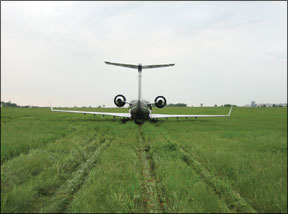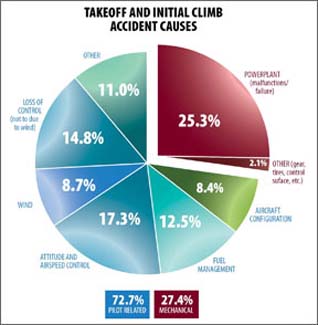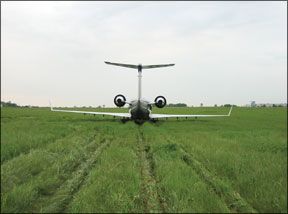Takeoff and initial climb accidents are 10 times more deadly than landing accidents, according to the AOPA Air Safety Foundation (ASF) presentation “Mastering Takeoffs and Landings.” And, when you think about it, the ASFs numbers make sense. After all, during a takeoff, the airplane is as heavy as it will be for that flight, youre accelerating, not slowing as when landing, and you arent accustomed to the wind or the airplanes loading, among other factors.
If in fact takeoffs are so potentially fatal, its worthwhile to discover how to detect when a takeoff or “first-stage” climbout is going bad and, if needed, how to safely

288
abort it before joining the NTSB tally. What clues do we have to a takeoff anomaly, and how can we safely abort a takeoff when things arent going right?
SO EASY a Caveman Can Do It
Well, maybe not all cavemen but at least in tricycle-gear trainers the student pilot makes the very first takeoff of his or her flying career (with instructor help, of course). Im in favor of letting the student do everything possible on the first lesson, but the relative ease at which we launch into the air-at least compared to what it takes to learn to land-might make us complacent about critically observing our takeoffs. After all, when turned into the wind and the powers brought up, were thinking about the flight ahead, or perhaps focused on an initial heading or altitude restriction. It takes a lot of discipline to be thinking about the takeoff itself.
To better evaluate our takeoffs in real-time its helpful to divide the process into the five phases listed above. Heres how to use them.
Pre-takeoff: A successful takeoff begins even before you board the airplane. This is when you evaluate aircraft, pilot technique and environmental factors that affect takeoff performance. How much distance will your takeoff require, and how long is the available runway? Are obstacles or rising terrain on your departure path? Whats the airplanes weight? How strong is the wind? What specific technique will you use for this particular takeoff? Should you use flaps, or not? Evaluating these questions, and planning to know and achieve the goals of the subsequent phases of your takeoff, needs to be made before flight, in the pre-takeoff phase.
Power: Are you getting maximum available power from your engine(s)? You wont know for certain unless you establish some specific power targets. Flying a fixed-pitch propeller airplane? You should know the static rpm (tachometer reading at full throttle with no forward motion), and compare it to what you see at the beginning of your takeoff roll. Same goes for the expected rpm further into the takeoff roll when airflow often permits a fixed-pitch prop to spin faster.
In airplanes with controllable-pitch propellers, know the expected manifold pressure and rpm at takeoff power. Most naturally aspirated (non-turbocharged) engines will read about one inch below ambient pressure at full throttle. At sea level, thatll be around 29 inches of manifold pressure; while taking off at Cincinnati youd expect about an inch below that (ambient pressure drops about one inch per 1000 feet above sea level in the lower atmosphere), and taking off from Denver full throttle will net about 24″ MP. Turbocharged engines should achieve their full, rated manifold pressure regardless of airport elevation.
In all gasoline aircraft engines (as opposed to diesels or turbines) mixture control is vital to achieving takeoff power. Many pilots who learn to fly at near-sea-level airports never learn what needs to be done with the “red knob” before a higher altitude takeoff. As pressure drops, a corresponding reduction in fuel flow is needed for maximum available power. This is exaggerated in larger, fuel-injected engines as they tend to be set excessively rich (extra fuel flow) at the full-rich position. Check your airplanes Pilots Operating Handbook (POH) for specific guidance but, in general, fixed-pitch propeller engines need to be leaned for maximum propeller

318
speed at full throttle. Those with controllable pitch propellers should be leaned per POH fuel flow tables (often placarded on the airplanes fuel flow gauge) or for a target Exhaust Gas Temperature (EGT) setting. Know what indication youre leaning for, and lean the mixture for that setting before beginning your takeoff roll.
Turbine pilots may have torque and/or temperature limits for takeoff, and often will not be able to go “full forward” with the power levers and remain within limits. Flying a turbine, you need to know the limiting factors for a specific takeoff and ensure maximum available power within those limits.
Acceleration: Youve made your pre-takeoff calculations and full power is available at the beginning of your takeoff roll. But are you accelerating as quickly as expected? If you are flying a large military airplane with multiple crewmembers you may have an acceleration chart that relates expected speed to time during the takeoff roll. For the rest of us, the measure of acceleration is subjective. Does it feel right? A better measure of acceleration is to visualize, beforehand, the point at which you expect to reach rotation speed. Pick a taxi turnoff, a runway distance-remaining sign, a tree alongside the runways clear area, or some other feature to positively identify the spot by which to lift off.
Liftoff: Reaching your liftoff speed target at the predetermined distance down the runway, raise the airplanes nose to the necessary attitude. Whether visually or on instruments, flying a heavy twin or light trainer, there is one attitude that provides optimum climb performance. Achieve that attitude (VX or, if runway distance and obstacles are absolutely no factor, a lower, VY attitude) and the airplane will climb smartly. A few degrees more “up” and induced drag may seriously degrade climb performance; a few degrees down from optimum pitch and climb rate may also be significantly eroded. Note that the airplanes attitude is power-dependent; it will be lower at higher density altitudes when power is reduced and the consequences of improper pitch are worse. On takeoff, especially when conditions require maximum performance, attitude is everything.
Initial climbout: For initial climb from takeoff to the transition to cruise climb (the transport-category folks call it “first stage” climb) you should have a pre-takeoff idea of your expected climb attitude and vertical speed. Compare real indications to what you expect to decide if your takeoff is going as planned, or if you need to recheck attitude, configuration (flaps and landing gear position) and power to safely climb away from the airport.
With knowledge of what you can expect in each phase of takeoff you can establish specific goals, or takeoff targets. Achieve a takeoff target and you know its safe to continue. Fail to meet a target and its time to abort the takeoff and figure out whats wrong.
Accelerate/Stop
Part 91 (private, noncommercial) flights have no specific runway length requirements. FAR 91.103 insists we “become familiar with all available information” regarding “runway lengths at airports of intended use” and “the takeoff…distance” contained in an approved flight manual (AFM) for the airplane. If no AFM is published for that aircraft type, we need to know “other reliable information appropriate to the aircraft, relating to aircraft performance under expected values of airport elevation and runway slope, aircraft gross weight, and wind and temperature.” If we can compute that our airplane as loaded will take 2500 feet to reach rotation speed given the runway and weather, then we can “legally” take off from a 2501-foot runway. But is that safe?
In the best of worlds youd be able to attempt a takeoff all the way up to rotation speed, detect a problem, and then abort, bringing the airplane to a stop before the end of the runway. In fact, most multiengine airplanes have whats called an “Accelerate/Stop” chart in the performance section of the POH to help pilots quantify this. “Accelerate/Stop” is the computed distance, considering aircraft weight, density altitude and wind, that it would take to begin a takeoff roll, reach rotation speed, immediately begin an abort, and come to a stop. Most multiengine pilots consider it prudent to operate only from airports meeting the accelerate/stop distance for their airplane, considering the increased statistical likelihood of having trouble during takeoff (all else is equal, and twice the engines means twice the likelihood one may balk on any given day).
Can I legally, and even safely, fly a twin out of an airport that doesnt meet published accelerate/stop criteria? Sure…but Ill know beforehand that an abort begun anywhere near rotation speed will cause me to go off the end of the runway, and I need to have a plan for what Ill do already in mind before advancing the throttles for takeoff.
What if you fly an airplane that doesnt have an accelerate/stop chart? You can approximate one if you remember your rotation speed is usually very close to your touchdown speed in the same airplane at the same weight. All you need to do to figure an accelerate/stop distance for your airplane is to compute the takeoff distance and the landing distance under takeoff conditions, and add the two.
Whether computed directly from an accelerate/stop chart or approximated using takeoff and landing distance computations, the resulting runway requirement does not assume any margin for reaction time, weak brakes or wet pavement. Its standard practice to multiply computed distances by at least 1.5, to allow for pilot reaction time and to provide a cushion for less-than-perfect braking surfaces or pilot technique.
How to Abort
What if you dont achieve one of your takeoff targets? What if a cabin door pops open, or an obstacle appears on the runway, or youre taking off into instrument meteorological conditions (IMC) and realize you left your instrument approach charts on the FBOs counter? Heres what you need to do to safely abort a takeoff:
Pay attention: Do everything you can to avoid the need for an abort before you ever reach the runway. Dont skimp on your preflight inspection; dont absentmindedly rush through the before-takeoff checklist. Brief your passengers to maintain a sterile cockpit (refrain from talking except in the case of clear danger). The purpose of all this preflight work is to keep you from having to abort in the first place.
Maintain control: Theres no better way to maximize your chance of survival and minimize the danger of damage than to keep the airplane under control. Keep the airplane wings level and the nose pointed straight ahead. Stay positively on the controls as long as possible.
Reduce power: Get the power to idle. The speed with which you need to reduce power-whether you should reduce or chop the throttle-depends on your circumstances.
Aborting from well below liftoff speed, with lots of remaining runway? Bring the power smoothly back to idle.
Rolling toward the last thousand feet of the runway? Get the throttle to idle now.
Lose an engine on takeoff in a twin-engine airplane? Chop the throttles to remove asymmetric thrust that threatens to force you off the side of the runway.
Wind blowing you off the side of the runway? If youre pulling to the left, reducing power (in most propeller airplanes) will make control easier. If drifting to the right, maintaining some power may help you keep it on the runway.
Regardless of the circumstances of your takeoff abort, the most important thing is maintaining control.
Apply brakes: After reducing power, brake as needed to come to a safe stop. If you feel the wheels slipping, then “pump” the brakes (apply and release the brakes in quick succession) until your speed is under control. Dont lock up the brakes; a skidding tire can quickly blow, making directional control almost impossible. It may be helpful to pull all the way back on the control yoke to keep weight firmly on the main wheels to maximize brake effectiveness.
Some POHs call for retracting any takeoff flaps to increase braking. If so, be very careful to select the proper handle for flap retraction. Many pilots have inadvertently retracted the landing gear when they thought they were retracting flaps.
Going Off the Runway
What if your takeoff abort is taking you off the side or the end of the runway? If time and maintaining aircraft control permits:
1. Pull the mixture control(s) or condition levers to idle cutoff. This quick action stops most fuel circulation in the engine compartment(s)-important for fire prevention if your runway departure leads to a collision and engine compartment damage (perhaps from collapse of the nosegear in rough or wet ground).
2. Turn fuel selector(s) OFF to prevent additional fuel from flowing to the engine(s)-where things are hot and ready to burn.
3. Turn off the alternator/generator and battery master switches. Electricity can spark a fire if you collide with something after leaving the runway; turning off the switches shuts off this dangerous ignition source.
4. Do not pull the propeller(s) to low rpm if flying airplanes with controllable-pitch props. At the higher rpm position prop blades create significant drag. Keeping the prop(s) full forward will help you stop sooner.
In turbine airplanes it may actually be safer to “abort to climb” if you lose an engine or otherwise fail to meet some takeoff targets. Trust me, though, the “accelerate-go” option rarely exists in multiengine piston airplane operations; if accelerate-go is available in the airplane you fly, youll know it because youll have practiced it numerous times in an approved simulator course.
If takeoffs are more potentially fatal than even landings, we need a way to identify and respond to problems before they lead to accidents. By establishing takeoff targets to anticipate performance, gauge actual to expected performance during takeoff, and immediately executing a preplanned takeoff abort technique if you fail to achieve a target, you will be better able to avoid a serious takeoff mishap.




